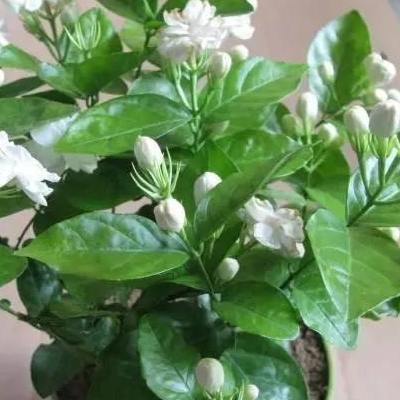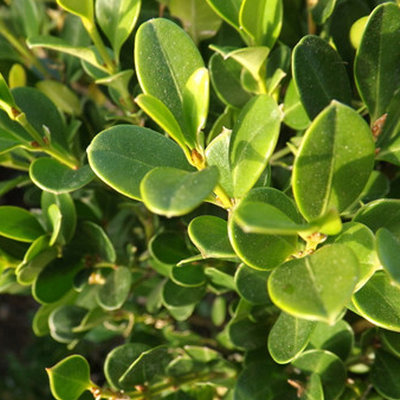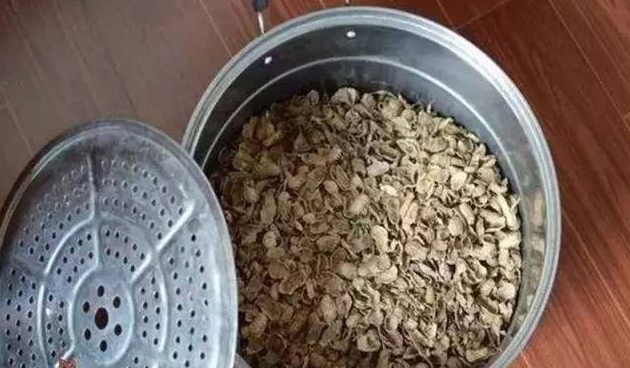How to raise jasmine and prolong its florescence? when to apply fertilizer?
Jasmine, this is a lot of people are super like, jasmine as long as blooming that is super fragrant, how to raise jasmine to prolong its flowering period? When to fertilize jasmine:

How to raise jasmine to prolong its flowering period:
In addition to the usual application of thin fertilizer and frequent application, let the plant grow stronger, the environment is ventilated and proper light, so that the jasmine can blossom normally.
If the flowering environment of jasmine is not ventilated, too much watering, too many buds or insufficient phosphorus and potassium fertilizer, it is easy to induce bud drop.
After the jasmine is in full bloom, the flowers should not be fully exposed, otherwise the flowering period will be shortened. If you want to keep the jasmine flowers for longer, you can temporarily move them to a slightly shaded place for maintenance and prolong the flowering period appropriately.
However, this method will reduce the fragrance of the flower because it has less light.
When to fertilize jasmine:
The maintenance of jasmine needs thin fertilizer and frequent application, and the growth period is usually given thin organic fertilizer once or twice a month to ensure adequate nutrients for growth, so that it has enough nutrients to nurture flower buds.
A little phosphorus and potassium fertilizer should be given before June to September to promote flower bud gestation.
This is the end of the introduction of the method of prolonging the flowering period of jasmine and the method of fertilization.
How to prolong the flowering period of jasmine
How to prolong the flowering period of jasmine 1. Choose loose soil
When planting jasmine, we must pay attention to the selection of loose soil cultivation, in short, no matter what kind of flowers are planted, we should use loose soil, because the drainage and ventilation are good, for flowers with poor root growth, it is easier to grow, at the bottom of the basin, put a little pond mud.
2. Keep plenty of light
Jasmine flowers like plenty of light, do not like dark flowers, as long as it is daytime, should be put outside, let it bask in the sun and light, but the summer can not be exposed to the sun.
3. Watering should be diligent
Be careful when watering jasmine. Water must be thoroughly watered until it is thoroughly watered. You can't water it every few days. Make sure you water it twice a day, preferably in the morning and in the evening.
4. Pruning frequently
If you want jasmine to bloom more, you must prune frequently. In summer, jasmine grows rapidly and has luxuriant branches and leaves. If the new branch grows too fast, it needs to be long, and it should be calculated from the branch, probably 10CM should be cut off, so that more lateral branches can grow.
5. Changing basin is reasonable.
If the domesticated jasmine has been kept for more than a year or two, you need to change the jasmine pot. The roots have been entangled for several years, and their ability to absorb water and air is not as good as it was a few years ago, so changing a large flowerpot and rematching it with loose soil can make jasmine glow in the second spring.
6. Replenish nutrition in time
It is necessary to apply reasonable fertilizer to grow jasmine. In the flowering stage, we should apply less nitrogen fertilizer, because the effect of nitrogen fertilizer is to promote the growth of leaves, too much nitrogen fertilizer will make the branches and leaves grow luxuriantly, but it will not not blossom but only grow leaves, so it is more appropriate to use nitrogen fertilizer in the seedling stage. In the flowering stage, the application of organic fertilizer is more effective, can promote flowering, and prolong the flowering period.
How to raise jasmine, the methods and precautions of jasmine culture / basking in the sun
Jasmine, needless to say, we must have seen, it is a more common potted flowers in life, the biggest feature is undoubtedly its pure white color. Generally speaking, how to raise jasmine is the same as other plants, but there are different points to pay attention to in the process of growing jasmine. The following are the breeding methods and matters needing attention of the jasmine arranged by the editor, which is very comprehensive. We might as well take a look at the cultivation mentioned in it.
First, how to raise jasmine, sunshine and watering
Generally speaking, the culture method of jasmine is relatively simple compared with Phalaenopsis, peony and other flowers, but it still takes some effort to plant jasmine well and prolong its flowering period. Light, watering, temperature, soil and so on are all we need to pay attention to, and then we will talk about them in detail.
II. Culture methods and matters needing attention of jasmine flowers
1. Loose soil
In the cultivation of jasmine, the most important thing to pay attention to is the soil. Jasmine is particularly sensitive to soil permeability, so it is more suitable to choose loose soil, which is easier for flowers with less developed roots such as jasmine.
Note: the alkaline basin soil will cause the leaves to turn yellow. When the leaves turn yellow, thin alum fertilizer can be applied every 5-7 days, and soon the yellowed leaves on the plant can change from yellow to green and gradually return to their original state. After that, it can be combined with fertilization, applying dilute alum fertilizer and water every 7 to 10 days, which can keep the leaves fresh green and grow normally.
Soil selection: 5 parts of rotten leaf soil (or peat soil), 4 parts of garden soil and 1 part of cake fertilizer were mixed, and a little bone powder was put on the bottom of the basin as base fertilizer. It is best to change the basin every year or every other year to replace the new soil. Watering thoroughly after changing the basin, and paying attention to loosening the soil, the temperature is kept between 22-24 ℃, which can accelerate the germination of new buds.
2. The light should be sufficient.
Jasmine is a light-loving flower, which likes strong direct light during the growing period. when the sunshine is more than 8 hours a day during the gestation and flowering period, the buds are full and white. So as long as it is daytime, flower friends should put it outside to receive enough light, but if it is midsummer, do not expose it to the sun.
Note: if the light is not enough, the branches and leaves of jasmine will jump, the color of the leaves is light, the branches are thin, the flowers are few, and the aroma is light. Therefore, in order to ensure sufficient light, it is a good choice to place jasmine on the balcony or roof.
3. Watering should be diligent
Because planting jasmine is suitable to choose loose soil, this kind of soil has good drainage, so we should pay attention to it when watering. Water must be thoroughly watered until the water has just seeped out of the bottom of the basin. But that doesn't mean it's enough. Florists are guaranteed to water at least twice a day, preferably once in the morning and once in the evening.
Note: once the jasmine is not watered enough, the jasmine will not grow well, and the leaves will be yellow and rare, so flower friends must water them frequently. As for when to water, there are two ways: ① looks at the pot soil to see if it is dry and wet, and whether it is dry or wet; ② taps his fingers on the flowerpot to listen to the sound, which means that the pot soil is dry, and his muffled voice means that the pot soil contains water.
4. Temperature: 25 ℃-35 ℃
Jasmine is a positive plant with long sunshine, and it is the most suitable for growth at 25 ℃ ~ 35 ℃. When the temperature is below 3 ℃, the twigs and leaves will suffer frost damage. When the lowest temperature is 0 ℃ and there is a slight frost, most of the leaves will fall off; at about 3 ℃ below zero, the branches are in danger of freezing, so the jasmine must be placed in a place with high temperature to grow.
Note: when the temperature drops to 5 ℃-10 ℃, the jasmine should be moved indoors and placed in the sunny window; when the temperature is below 0 ℃, the potted flowers should be removed from the window at night, lest the cold wind blow through the window and freeze the jasmine; when the room is frozen, at night, polyethylene film bags should be used to cover the potted flowers with the bottom and tie the mouth of the bag tightly, then put the potted flowers in a warmer place. In order to avoid the danger of suffocation of jasmine, you can also poke a few small holes in the bag.
5. Rational fertilization
Jasmine is fond of fertilizer and is suitable for the growth of fertile, loose and well-structured sandy soil and loam with a pH value of 5.5-7. However, less nitrogen fertilizer should be applied at flowering stage, because the effect of nitrogen fertilizer is to promote leaf growth, too much nitrogen fertilizer will make jasmine branches and leaves grow luxuriantly but do not blossom, so nitrogen fertilizer is more suitable for seedling stage. During the flowering stage, the application of organic fertilizer will be more effective, which can promote flowering and prolong the flowering period.
Note: sometimes jasmine flowers will only grow leaves but do not blossom, the main reason is lack of light, and second, too much nitrogen fertilizer. Because jasmine flowers should be exposed to the sun for at least 6 hours a day, and the branches that do not blossom should be treated at the same time; second, we should use less nitrogen fertilizer and more phosphorus fertilizer.
6. Pruning frequently
In the cultivation method of jasmine, learning to prune is a very important link. Necessary and appropriate pruning of jasmine can not only ensure the storage of nutrients of jasmine itself, facilitate the growth of new branches and the germination of new flower buds, but also ensure the beauty of the tree shape, but also make use of the cutting propagation of strong branches under pruning to ensure the replacement of new and old jasmine.
Note: when the day is right, jasmine grows rapidly and has luxuriant branches and leaves. If the new branch grows too fast and slender, the 10CM should be cut off from the branch to promote more lateral branches to grow.
7. Change the basin reasonably
It is necessary to change the pot of jasmine which has been planted for more than 2 years. At this time, the roots of jasmine have been entangled and confused, and the ability to absorb water and air has been greatly reduced. Loosening the soil alone can no longer solve practical problems. Change a larger flowerpot and match it with loose soil to make jasmine coruscate its second spring.
Note: when the jasmine flowers planted in the pot grow up from small to small, and the roots cover the whole basin, the plant needs to change from the small pot to the large pot. Generally, before the jasmine sprouts, the root system is pruned and then a larger basin is replaced.
8. Pest control
Jasmine is a flower that is not susceptible to insect pests, but it is necessary to take some necessary precautions if you want to bloom well. Red spider is one of the common pests when planting jasmine, and the corresponding insecticide is easy to buy, which is introduced in the pest control of potted jasmine.
Note: when spraying liquid, do not just focus on spraying jasmine leaves and flowers, the soil must also be sprayed, otherwise pests will not be completely cured. For infected leaves, they should be removed in time.
- Prev

How to water and fertilize the production method of boxwood bonsai
Boxwood, this is a kind of tree, this boxwood can be seen in many places, such as parks and so on, what is the method of making boxwood bonsai? How to water and fertilize boxwood: Poplar bonsai production method: material
- Next

What are the advantages of how to grow flowers in peanut shells
Peanut shell, this is all seen before, this peanut shell is no one to eat, this peanut shell taste is not good, peanut shell how to grow flowers? What are the advantages of peanut shell: how to grow flowers: step 1: crush the peanut shell at home, preferably fried and original peanut shell
Related
- Fuxing push coffee new agricultural production and marketing class: lack of small-scale processing plants
- Jujube rice field leisure farm deep ploughing Yilan for five years to create a space for organic food and play
- Nongyu Farm-A trial of organic papaya for brave women with advanced technology
- Four points for attention in the prevention and control of diseases and insect pests of edible fungi
- How to add nutrient solution to Edible Fungi
- Is there any good way to control edible fungus mites?
- Open Inoculation Technology of Edible Fungi
- Is there any clever way to use fertilizer for edible fungus in winter?
- What agents are used to kill the pathogens of edible fungi in the mushroom shed?
- Rapid drying of Edible Fungi

